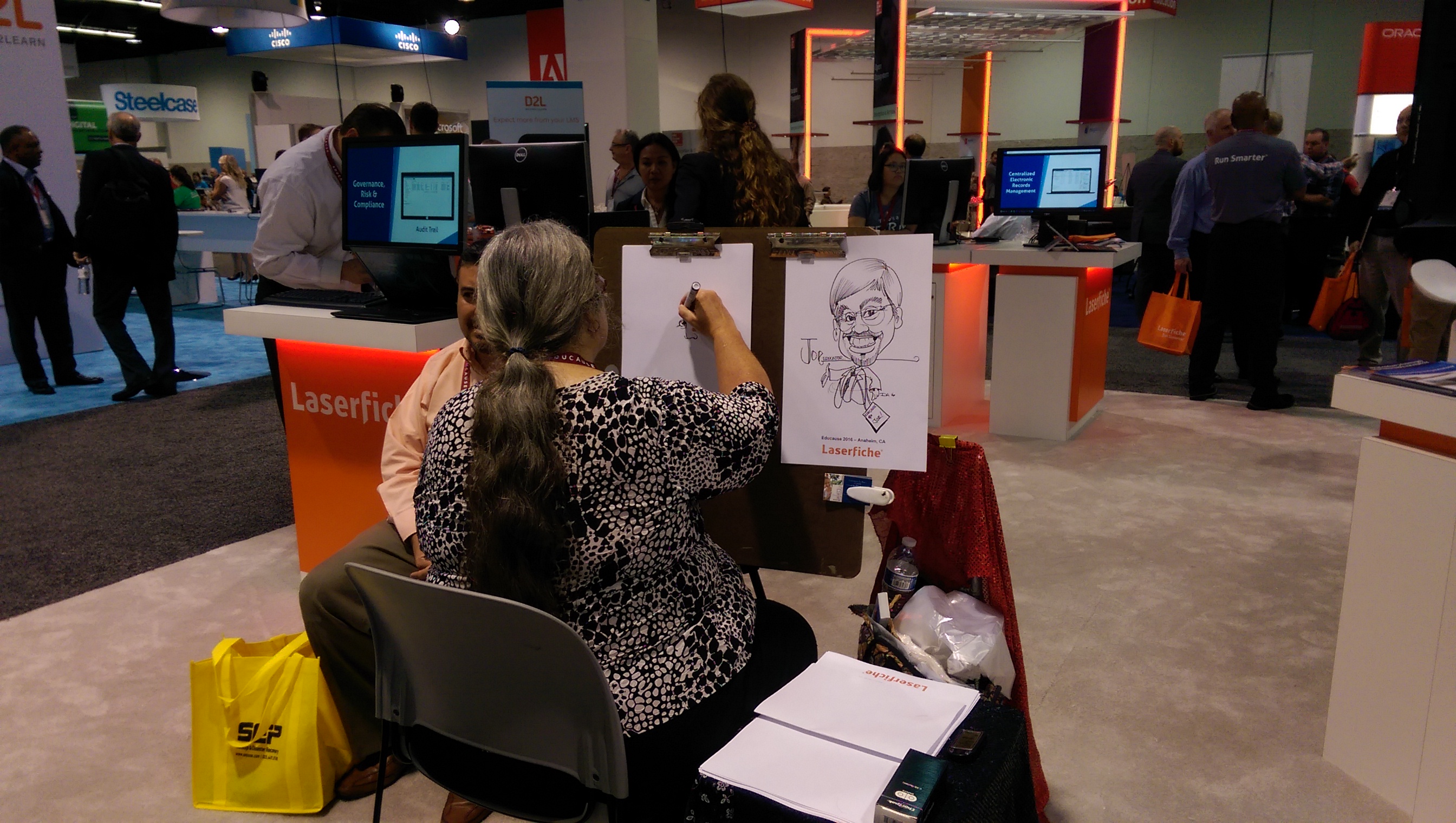Switches, routers, panels and projectors. Canvas, whiteboards and a company called Blackboard. Cornhole, crane games, magic shows and light-up swords. There were people dressed as blue aardvarks and consultants representing Pink Elephant.
The full stack of technologies and frivolous thrills one might expect to find on today’s college campuses were on full display at Educause, the hulking gathering of higher-ed technology staff, faculty and companies. More than 7,000 attendees, representing 1,800 institutions across 14 countries, made the trek to Anaheim.
The smorgasbord of hardware and software at the show floor caters to a wide range of university IT needs, from security and bandwidth to proctoring and instruction. Yet for many C-level administrators, roles that were previously siloed are beginning to merge, observes John O’Brien, president and CEO of Educause. No longer, he says, does it make sense for colleges to divorce technology from teaching and learning.
As schools increasingly outsource services to companies, “going from managing staff to managing vendors requires a whole new set of capabilities and skills for CIOs [chief information officers],” he tells EdSurge.
There’s a need, too, he adds, for traditional IT leaders get in touch with their academic peers. “Our data suggests that CIOs are less part of academic decision-making than we would hope,” he adds. “I’ll be really happy if in a few years their job has changed to become much more focused on building relationships across divisions that have had barriers in the past.”
Here’s what we heard and overheard on the show floor, panel sessions and serendipitous lobby conversations on Day 1. Check out our coverage from Day 2 here.
DECODING DIGITAL LITERACY: Ask 450 educators to define “digital literacy,” and you’ll likely get dozens of answers. That’s what an Adobe-commission survey, published in partnership with futurist Bryan Alexander and the New Media Consortium, revealed. The soft skills most commonly affiliated with the term include critical thinking, problem-solving, creativity and, perhaps surprisingly, copyright knowledge.
“It’s crucial to recognize that students are makers and producers of content,” Alexander states. “That’s a major institutional shift and opens up new roles for faculty.”
To establish create a common set of definitions around digital literacy, the report proposes three buckets of literacies: “universal literacy,” or being adept at using basic productivity (word processing, image manipulation, content authoring) tools; “creative literacy,” which involves more technical and specialized content-creation skills (such as video editing and animation); and cross-disciplinary literacies that combine humanities studies with digital social media. (How might a sociology class analyze human interactions and behaviors on social media?)
Alexander sees an uptick in collaborations between businesses and universities, “especially now that colleges are under the spotlight to prove they’re preparing students for careers.” He believes chief academic officers are best positioned to lead and implement a campus-wide strategy around building digital literacies.
FUN SAD FACT: According to Avi Yashchin, Senior Offering Manager at IBM Watson: “Sadness [sentiments] in incoming freshman college application essay is the sixth strongest predictor of dropout.” (Solution: offer happier prompts?)
DECIPHERING ‘DATA’: Yaschin also offered this analogy for how educators can think of Big Data:
“There are descriptive, predictive and prescriptive analytics. Think about it like a car. Your descriptive analytics is the speedometer that shows how fast you are going. Your predictive analog is the thing that says, ‘Given you have 12 gallons left in your car and you get 28 miles per gallon, here’s how much further you can go.’ Your prescriptive solution is your GPS that shows you how to get to your destination.” In an ideal world, all three work in tandem to offer faculty actionable and real-time insights on what a struggling needs most.

STATE OF THE IT DEPT.: What better place to reveal the results of a national survey about trends in IT than at Educause? University IT departments are still feeling the effects of budget cuts from the recession, according to the 2016 Campus Computing Survey. Three in 10 respondents—chief information officers and senior IT officers—said they started the academic year off with a smaller budget than the previous year. Their No. 1 priority for 2016? Hiring and retaining IT talent.
PROVING THEIR WORTH: For colleges, “the era of, ‘Trust us, we’re worth it’ is over,” says F. King Alexander, president of Louisiana State University, during a session on the “leading edge of higher education innovation.” He challenged colleges to embrace efforts to share data such as how many graduates get jobs to show the value colleges deliver. “What higher education has been good at doing is keeping information out of the hands of consumers” and students, he adds.
WHAT DO PROFESSORS WANT FROM LEARNING ANALYTICS? An unusual survey conducted at colleges across Australia asked professors what kind of data would help them teach better. It is important to ask, argues Deborah West, director of the Office of Learning and Teaching for Charles Darwin University, in Australia, because professors are often left out of planning for so-called “learning analytics.” It turns out that academics in the survey were most interested in getting a better understanding of who’s in their courses—details like student demographic information and prior academic history. West summarizes their overall attitude as: “Tell me what data is available, give me access to it, give me the time to use it, and give me guidance in using it.”
When she presented the findings in a session here, thorny issues around data quickly emerged. One was student skepticism about what is being collected about them. And one adjunct faculty member says that once she got better data on how students are proceeding through course materials, she and other professors get frustrated that they don’t have time to make adjustments to their courses to respond to what they learn. West says that’s where colleges need to make clear about what support is available as they start sharing data. Bringing data into college classrooms amounts to a “cultural transformation,” she argues, and requires leaders who are bilingual—speaking “IT as well as the academic.”

From the Vendor Hall
IMMERSE YOURSELF: EdSurge donned Microsoft’s HoloLens augmented reality headset to catch a glimpse of how AR technologies might impact education. Pearson Education announced it’s developing mixed reality content for HoloLens so that students can have (semi) real-world experiences in the classroom.
Pearson is currently piloting HoloLens content in physics classes at Bryn Mawr College and construction courses at the Royal School of Military Engineering the U.K. The company is also working with Texas Tech University and San Diego State University to create patient simulations for nursing students. Mark Christian, director of immersive learning at Pearson, says his goal is “to provide the tools that teachers can use to do the impossible.”
BLACKBOARD'S NEW FRONTEER: Blackboard acquired Fronteer, the U.K.-based developer of Ally, a tool that makes digital content more accessible for learners with special needs. Terms of the deal were not disclosed.
FROM JEOPARDY TO TUTORING: Pearson is adding IBM’s Watson as a tutor to its online college courses. Students will be able to ask Watson open-ended questions related to their course content, and the intelligent tutoring system will also provide instructors with insights about how well students are learning and where they might need extra help. Watson will also be able to generate “concept clusters” for learners—showing them how what they’re learning relates to other points they’ve studied.
“At the intersection of cognitive sciences and computing there’s an opportunity to transform educational technology,” says Satya Nitta, IBM’s program director of cognitive science and education technology. He pointed to a recent computer science class at Georgia Tech, where the professor had teaching assistants and a computer respond to student questions—without telling the students that they might be interacting with a machine. The bot, “Jill Watson,” passed the Turing test—students thought they were interacting with a human TA.
TOO FLY: Drones are dangerous. A growing headache, apparently, for many IT staff is the growing number of such contraptions buzzing around campus, flown by students, faculty and researchers. One company, AirMap, is offering a tool that helps administrators streamline permit requests to fly drones, along with a real-time map similar to what an air traffic controller may see.

ARRIVING THIS FALL: Desire2Learn launches updates on a seasonal basis, and its autumn upgrades to its learning management system, Brightspace, offers instructors the capability to create, deliver and assess video assignments to students. “It’s one thing to be ask students to write a document or take a test. It’s another thing to ask them to perform the task.”
What Keeps A Futurist Optimistic?
For Bryan Alexander, who embraces that title, the answer is Generation Z. (Those born in the late 1990’s and early 2000’s.) “I look at these kids who don’t remember the world before Sept. 11, and went through the Great Recession as children,” he tells EdSurge. “People older than [them] think [they] are coddled infants and spoiled brats, but those same adults are busy cooking the world, and our politics are a nightmare. I look at these 18, 16, 14-year-olds….they’re creative and fantastic. I don’t think we deserve them. But they keep me going.”
Futurists can foresee trends that get adopted a decade later. Back in the 90’s, Alexander led a course involving simulation games, discussion boards, video conferencing, peer-to-peer technologies like chatroom—digital collaborative experience that were ahead of this time. (“But this stuff works now!”)
Yet he is not perfectly clairvoyant. One prediction Alexander says he got “massively wrong” was that colleges would spend less on athletics. “College sports is a beast that must be tamed,” he recalled former University of Michigan president Jim Duderstadt, saying. “But it didn’t.”


